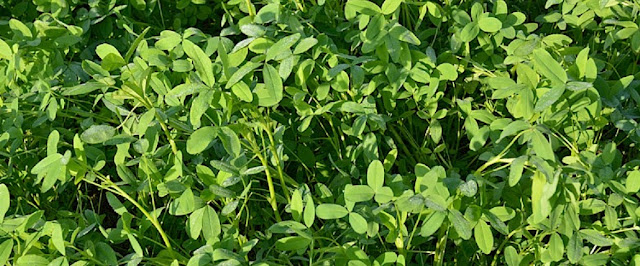Cultivation of Berseem ; A complete Information Guide
Cultivation of Berseem ; A complete Information Guide
Introduction
Berseem or Egyptian clover (Trifolium alexandrinum L.) is popularly known as the King of fodder crops for the irrigated condition of Northern India because It is available for 6-7 month from November to May, give 4 to 6 cuts during winter, spring, and early summer seasons and provides nutrition, succulent and palatable forage, milch animals yielding up to liters of milk can be maintained with a little supplement of concentrate mixture.
Climatic Requirements for Berseem cultivation;
Berseem is adapted to a dry cool and moderately cold climate. Berseem is not sown unless the average daily temperature is 13 to 15 degrees celsius. The optimum temperature at the time of sowing berseem is 25 degrees celsius. For Iuxuriant vegetative growth temperature range of 25 to 27degree celsius has been found ideal. The uniformly high temperature in south Indian conditions limits the cultivation of berseem.
Soil Requirement for Barseem Cultivation;
Well-drained clay to clay loam soils rich in humus, calcium, and phosphorus are suitable for a good crop of berseem. However, it can be grown on sandy loam soil but requires frequent irrigation. Comparatively heavy textured soils are considered better due to greater water-retaining capacity and congenial edaphic environments for crop persistency.
Field Preparation for Berseem Cultivation;
Important Varieties of Barseem ;
Crop Rotation and Mixed Cropping ;
Seed & Sowing of Berseem Crop;
Usually, Kasani (Chicorium intybus) seed is found admixed with berseem seed. Since the size of chicory, seed resembles with berseem seed; it becomes difficult to separate them by ordinary methods. However, the seed of the berseem is oval while the seed is conical. To remove chicory seeds, a 10% common salt solution is used. The chicory seeds being lighter in weight than berseem seeds float on the surface while berseem seeds settle down at the bottom of the container. In this way, chicory seeds may be drained off and berseem seed collected.
Being a leguminous crop, berseem enriches the soil with sizeable quantities of nitrogen through symbiotic nitrogen fixation with the help of Rhizobium bacteria. Therefore, berseem seed should be inoculated with a culture of Rhizobium trifollii to enhance the process of biological nitrogen fixation in root nodules especially in soils where berseem is being grown for the first time
Under normal conditions, the optimum seed rate of berseem has been found to be 25 kg/ha. When the sowing is taken up earlier than the appropriate time, the quantity of seed used is increased by 15to20%to to compensate for the loss of seedling mortality occurring due to prevailing high atmospheric temperature.
Sowing time is an important factor governing germination, seedling survival, number of cuts, and herbage production. Berseem should be sown when the temperature is in the range of 25-27degree celsius. Thus, the optimum sowing time of berseem in Punjab, Haryana, and Uttar Pradesh (the bowl cultivation) is the entire month of October.
E) Sowing method:
There are two methods of berseem sowing ;
Fertilizer Requirement in Berseem Cultivation :
Irrigation management in Berseem Cultivation ;
Berseem requires huge quantities of water for producing high succulent biomass. For every kilogram of plant dry matter produced as much as 500 kilograms of more or water may be necessary for a dry climate. Therefore, adequate and timely water supply is one the basic inputs for obtaining potential crop yield which necessitates precise knowledge of irrigation techniques and approaches in the berseem crops. Apply first irrigation, within 3 to 5 days in light soil and 6-8 days in heavy soils. The remaining irrigation should be applied at 8-10 days intervals in summer and 10-15 days during winter.
Weed management in Berseem Crop ;
Weed management is one of the vital components of berseem production. The major associated weed of the berseem crop is chicory (Chicorium intybus). The nature of this weed is such that it infests from field to seed and vice-versa. The intensity of field infestations could be minimized by treatment with a 10% solution of common salt and deep summer ploughing with soil inversion plough after the final harvest of the crop.
Disease management in Berseem;
During the month of December and January when the crop attains luxuriant vegetative growth and cloudy days persist for a longer period, the heavy infestation of fungal diseases such as root rot caused by Rhizoctenia soloni and Fusanlum smitactum and stem rot caused by sclerotinia trifoliorum occur. If the crop is cut the fungal growth in patches can easily be seen. As rotten stubbles. It has been observed that the problem is more acute under the following situation:
1) Field is heavily manured with undecomposed farmyard manure and/or irrigated with sewage.
2) Water stagnated creation damp conditions.
3) Light penetration at the ground is curtailed due to delayed cutting.
4) Cloudy condition prevails for a longer period.
Agronomic approaches to solving this problem include.
1) Avoiding the growing of berseem crop in the same field year after year and deep ploughing during summer.
2) Using well rotten manure in proper quantities.
Fertilizing the crop with a heavy dose of potassium.
3) Leveling the field properly to avoid water stagnation.
4) Avoiding too frequent irrigations during cloudy days.
5) Cutting the crop frequently to expose the ground for adequate light availability.
Harvesting & Threshing Berseem Crop;
Forage quality:
1) Berseem is highly nutritious, succulent, and palatable forage for all types of livestock.
The yield of Berseem Crop;
The forge yield potential of the berseem crop is very high. The crop is capable of producing 1000 to 1200 q/ha of green forage under improved agronomic management practices and favorable weather conditions. Mixing Japan rape or Chines cabbage 2.25 kg seed/ha increases the yield by 20-25 percent in the first cut. The yield may further be increased by introducing early cutting.







Pingback: Cultivation of Lucerne (Medicago sativa) or Alfalfa in India - Agrovista-Farming